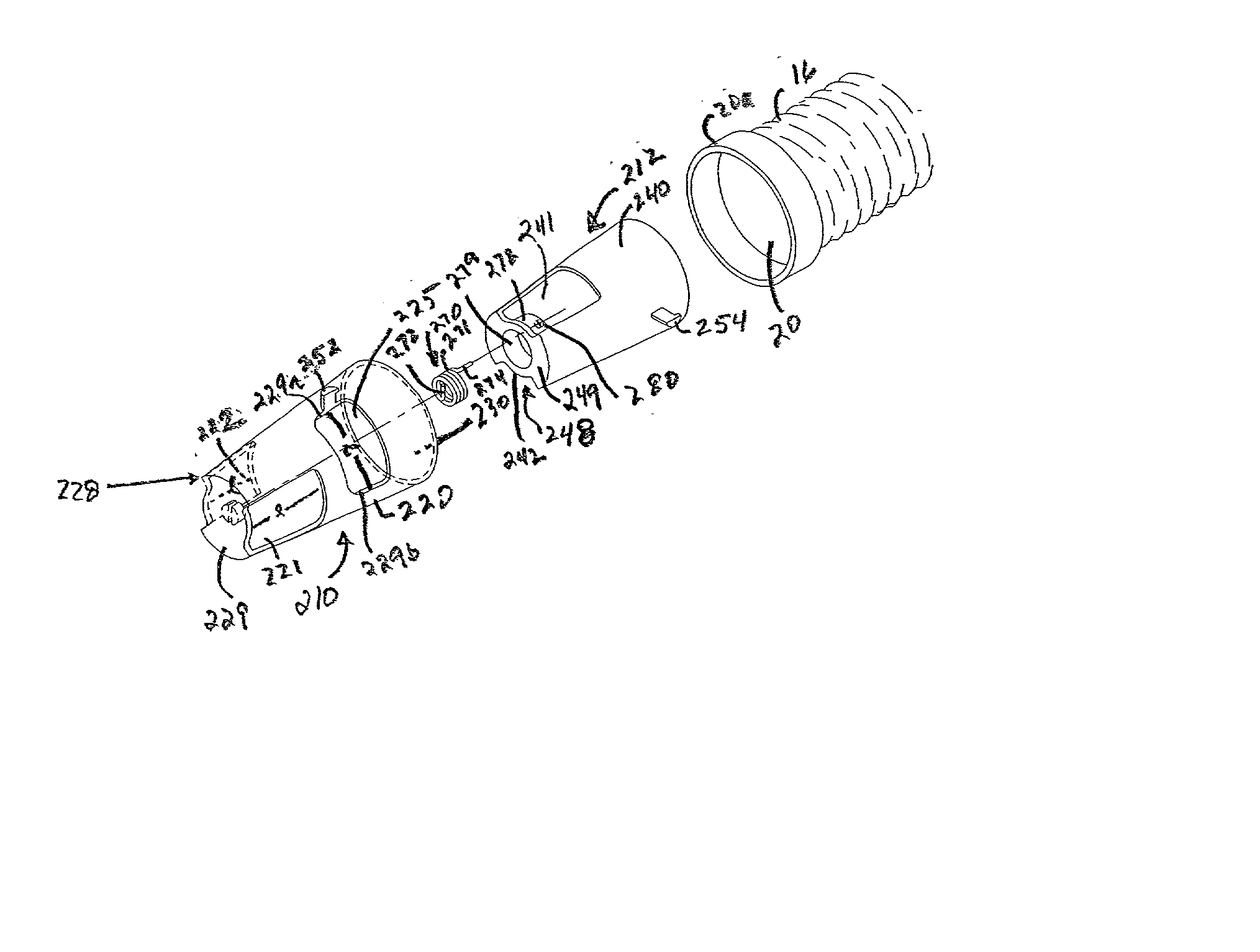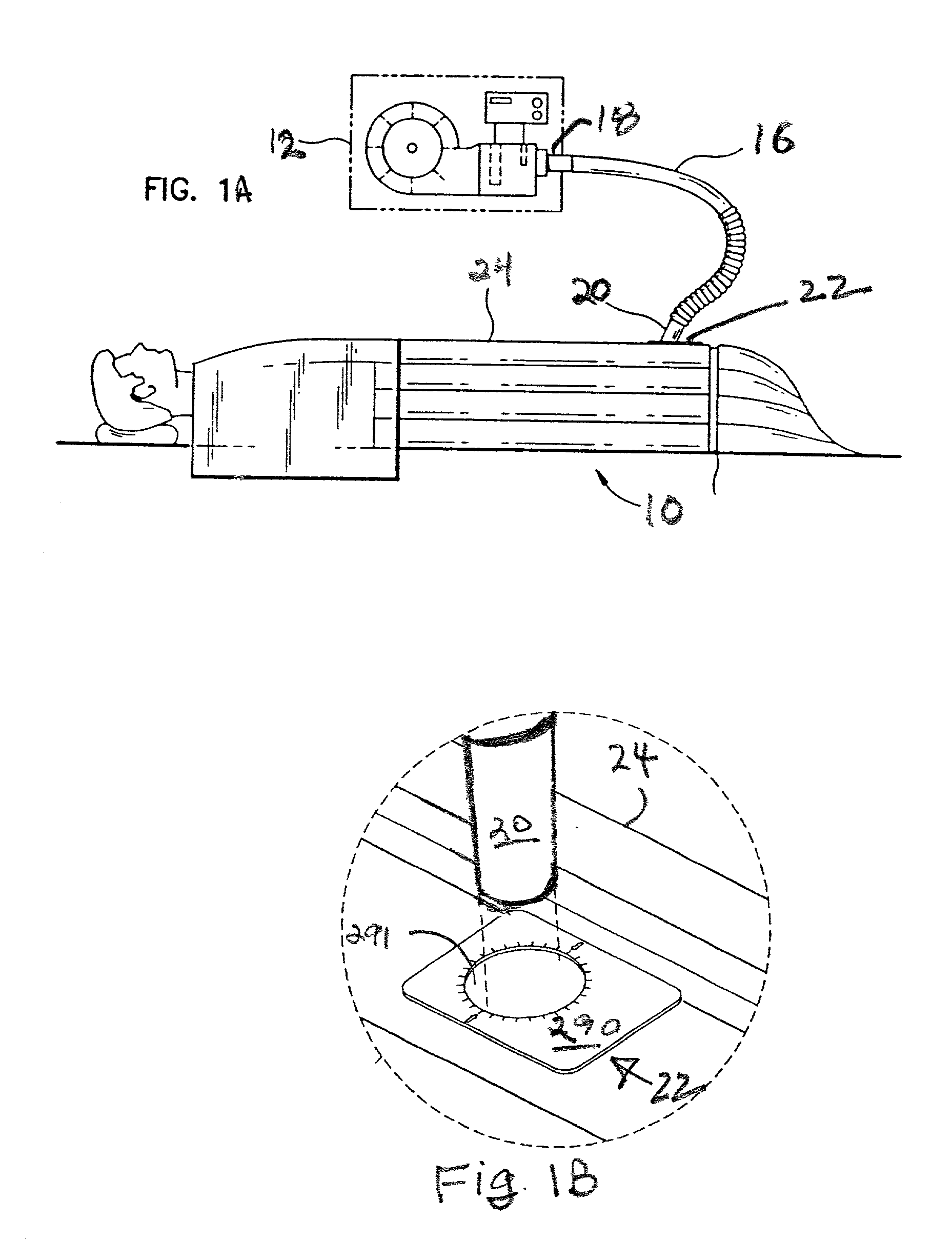System, combination and method for controlling airflow in convective treatment
a technology of convective treatment and airflow, which is applied in lighting and heating apparatus, ventilation systems, heating types, etc., can solve the problems of tissue damage, fluid temperature at the distal end of the duct system may be affected, and heat loss from the convective treatment system
- Summary
- Abstract
- Description
- Claims
- Application Information
AI Technical Summary
Benefits of technology
Problems solved by technology
Method used
Image
Examples
embodiment 400
[0049] Refer now to FIGS. 4A and 4B for an understanding of another embodiment of the interface device. In these figures, the interface device embodiment 400 includes a sleeve 418 of flexible material having an open end 422 that transitions to a shallow bowl-like collar and an end 424 that has a normally closed configuration in which opposing sections of the sleeve 418 at the end 424 abut without being permanently joined. The sleeve 418 is made of a durable flexible plastic such as polypropylene or polyethylene and has a remembered shape that maintains the end 424 in its normally closed configuration. Opposing longitudinal living hinges 415 and 417 connect two opposing segments 419 and 420 of the sleeve 418. Forces applied in opposition to the living hinges 415 and 417 near the end 424 (indicated by arrows 435) cause the end 424 to open and the sleeve 418 to assume an open tubular configuration. When the opposing forces 435 are released, the sleeve 418 returns to its remembered shap...
embodiment 500
[0052] Refer now to FIGS. 5A-5C for an understanding of another embodiment of the interface device. In these figures, the interface device embodiment 500 includes a spring structure with a base ring 510 having an opening 511. An imaginary axis A, centered in and perpendicular to the base ring 510, may be defined. A pair of elongate flexible tines 512 and 514 are mounted in opposition on one surface of the base ring 510, extending along and beside the axis A. The other surface of the base ring 510 has the same shape and dimensions as the annulus 20a. The flexible tines 512 have the shapes of shallow descending arcs that open in opposite directions away from the axis A. The flexible tines 512 and 514 are formed from any appropriate flexible material that retains a memory of its original shape when flexed by an applied force and that returns to the remembered shape when the force is removed. One such material is a sturdy, durable plastic such as polypropylene or polyethylene. The flexi...
embodiment 600
[0054] Refer now to FIGS. 6A and 6B for an understanding of another embodiment of the interface device. In these figures, the interface device embodiment 600 includes a single frusto-conical section 610 made of a durable flexible material such as plastic and having a narrow end 628 and a wide end 630. Both of the ends 628 and 630 are open, and the wide end 630 transitions to a shallow bowl-like collar. At the narrow end 628 there are four elongate slots 612 that extend from the end 628 longitudinally along the section 610 for about a third of the length of the section 610. The slots are arrayed at 90.degree. around the narrow end 628 of the section 610 and define four corresponding legs 614 extending from the narrow end 628. The legs 614 are flexible and can be flexed inwardly toward one another. A ball or sphere 620 of light durable material such as plastic is disposed on the inside of the section 610, wherein it is free to move between the narrow end 628 and the wide end 630. The ...
PUM
 Login to View More
Login to View More Abstract
Description
Claims
Application Information
 Login to View More
Login to View More - R&D
- Intellectual Property
- Life Sciences
- Materials
- Tech Scout
- Unparalleled Data Quality
- Higher Quality Content
- 60% Fewer Hallucinations
Browse by: Latest US Patents, China's latest patents, Technical Efficacy Thesaurus, Application Domain, Technology Topic, Popular Technical Reports.
© 2025 PatSnap. All rights reserved.Legal|Privacy policy|Modern Slavery Act Transparency Statement|Sitemap|About US| Contact US: help@patsnap.com



